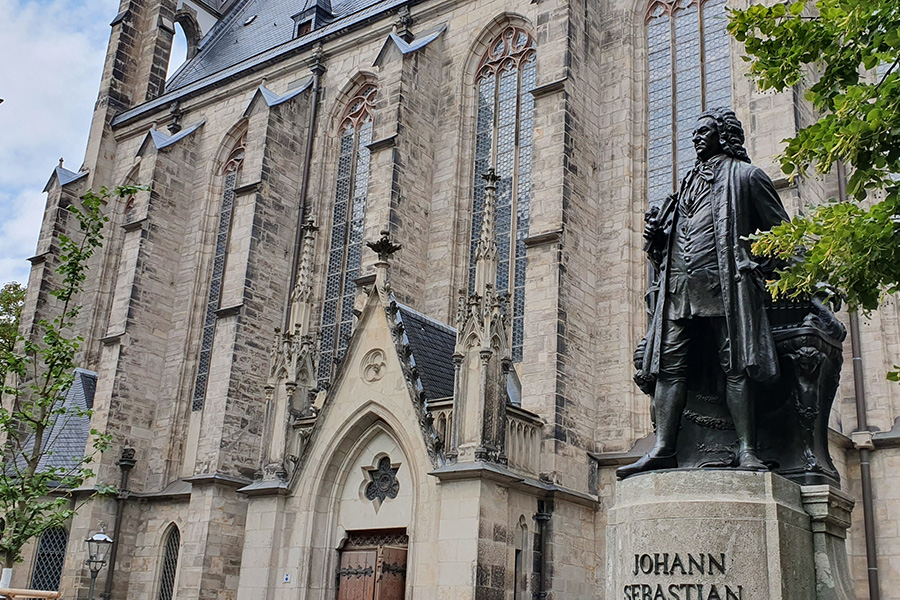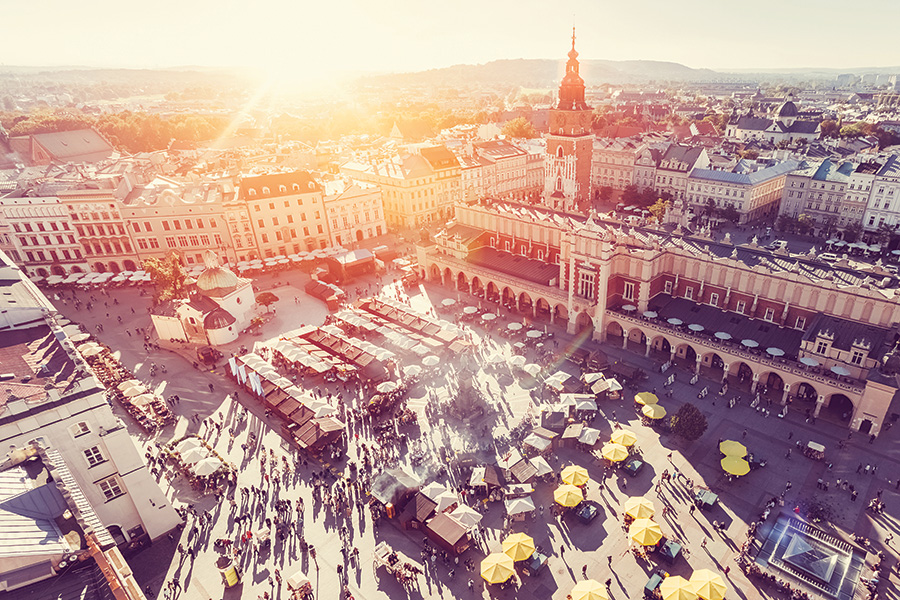A Look at the Countries Bostonians Emigrated From
To understand modern Boston, you have to look to the past.

Statue of Johann Sebastian Bach at the St. Thomas Church in Leipzig. / Photo via Wikimedia Commons/Yair Haklai
Germany
Bostonians with German Heritage: 30,436
Although some Germans made their way to the Hub in the late 1700s to escape hardship in the southwestern region of the country, most crossed the Atlantic from 1820 through 1880 during what was known as the first wave of migration from Europe, leaving major port cities such as Bremen. They established strongholds throughout Boston, with notable concentrations in the North End and the Fort Hill section of Roxbury.
IF YOU GO: Classical music in your blood? The city of Leipzig, the birthplace of composers such as Johann Christian Bach and Richard Wagner, hosts the Bach Festival this year from June 11 to 21. If you’re heading north to trace your roots in Bremen, you’ll want to peep the 15th-century Town Hall and Bremen Roland knight statue, both UNESCO World Heritage sites, at the Marktplatz. Those with ancestors in Rhineland-Palatinate should swing by the spa town of Bad Dürkheim, along the historical German wine route, to see the world’s largest wine barrel and sample top-notch Rieslings during the Wurstmarkt festival in September. —Victoria Abbott Riccardi
El Salvador
Bostonians with Salvadoran Heritage: 14,438
Over the past few decades, natural and manmade disasters alike have driven thousands of Salvadorans to leave their country and settle in Boston—East Boston, to be exact. Today, 80 percent of Boston’s total Salvadoran population lives in Eastie, making them far and away the largest population in the neighborhood. Take a stroll through East Boston, and you’ll see many Salvadoran-owned businesses, several of which sell pupusas, the delicious corn-stuffed tortillas topped with pickled cabbage that are practically synonymous with the tiny Central American nation.
IF YOU GO: Take a drive on the 22-mile Ruta de las Flores, a winding route that passes through a series of quaint, colorful colonial-era towns and coffee farms in the shadows of volcanoes. For a deeper dive into El Salvador’s heritage, visit the pre-Columbian Joya de Cerén and Tazumal archeological ruins. Or honor the cultural heritage of the country in the picturesque lakefront town of Suchitoto, known for its art festivals and galleries. —Catherine Elton
Italy
Bostonians with Italian Heritage: 53,016
The journey to Boston started at the top of the Boot, with the first Italians arriving from Genoa and northern Italy in the mid- to late 1800s to take advantage of the city’s booming industrial economy. Soon after, throngs of Sicilians unpacked their suitcases, along with those from Campania, Abruzzi, and Molise, escaping citrus and olive crop failures and devastating eruptions from Mount Etna and Vesuvius. Their heritage, of course, is today’s North End, where immigrants once sardined themselves into densely packed tenement buildings.
IF YOU GO: Let the port city of Genoa welcome you home with a picturesque harbor lined with shops, restaurants, and the Galata Museo del Mare, which showcases 600 years of maritime history. Those who just want to learn how to replicate their Nonna’s seafood pasta, meanwhile, can stop by LoveSicily, a cooking school in the southern town of Modica. Have ancestors from Naples? Head below the city streets with Naples Underground to discover the remains of a Roman theater where the emperor Nero once performed. —V.A.R.

There’s history at every turn in Kraków. / Photo via Martin Dimitrov/Getty Images
Poland
Number of Bostonians with Polish Heritage: 16,155
Offering a haven from religious persecution (not to mention better job prospects), Boston has been welcoming Polish immigrants since the late 19th century. Some came from the Prussian-ruled provinces of Posen and Pomerania that were part of Greater
Poland, while others lived in Russia and Austria-Hungary. A second wave arrived after World War II from as far as Siberia, where they’d been deported by the Soviet government; they settled largely in what became known as the Polish Triangle, located in Dorchester and a small part of South Boston. Although you can still hear the Polish language and find shops and restaurants serving smoked kielbasa and jelly-filled paczki (doughnuts) there, younger generations have moved outside the city to set down roots.
IF YOU GO: When you’ve fully explored Warsaw’s Old Town, including such landmarks as the Royal Castle, St. John the Baptist Cathedral, and the Fryderyk Chopin Museum, rest your tired feet at Nobu Hotel Warsaw, opening this spring with 117 ultramodern rooms and a signature Nobu restaurant. Have ancestors from or around Kraków? Take a stroll through Oskar Schindler’s Enamel Factory, a former metalworking facility that now features an exhibit exploring the Nazi occupation of Kraków and is adjacent to the city’s Museum of Contemporary Art. Catch the flip side of Poland’s urban landscape with an excursion to the Tatra Mountains, which extend into Slovakia and showcase glacier lakes, waterfalls, and hiking paths throughout their enchanting ridges and valleys. Mount Kasprowy has a cable car to whoosh you to the breathtaking top. —V.A.R.
Russia
Bostonians with Russian Heritage: 10,401
Religious persecution drove Russians, mainly Jews, from the Pale of Settlement (a Czarist Russian region between the Baltic and Black seas) toward Boston’s shores from 1880 to 1921. They arrived by way of Western Europe, ultimately sailing out of Germany’s two largest port towns, Bremen and Hamburg, before settling in Boston’s West End and North End, welcoming first homes for many immigrants.
IF YOU GO: Founded in 1764 by Empress Catherine the Great, St. Petersburg’s impressive State Hermitage Museum overflows with more than 3 million works of art ranging from prints and porcelain to royal horse-drawn carriages. Want to really step back in time? Kizhi Pogost, an uninhabited historical settlement of spired wooden buildings on Lake Onega’s Kizhi Island, showcases two 18th-century churches with onion domes and 22 dazzling cupolas. If you’re taking a trip to Moscow, Grand Café Dr. Zhivago, which overlooks Red Square in the Hotel National Moscow, is the spot to savor traditional foods, including caviar and blini, with shots of icy vodka. —V.A.R.
Dominican Republic
Bostonians with Dominican Heritage: 35,656
Long before Big Papi boomed, “This is our f*cking city” into a microphone at Fenway, Dominicans began making the 1,600-mile trek north to Boston. They arrived mainly between 1960 and 1980 in search of economic opportunities—and to escape political and military turmoil—mostly from the northern Cibao Valley region. Once here, the newly minted Bostonians settled in Dorchester, Mattapan, Roslindale, and Hyde Park, where the majority still live.
IF YOU GO: Need a little pick-me-up after trekking through the Colonial Zone of Santo Domingo, a UNESCO World Heritage site? Pop by the ChocoMuseo to learn the history of one of the country’s popular exports and join a chocolate-making workshop. Another beloved export is larimar, a turquoise-like stone that’s found nowhere else in the world. At reputable shops such as the Larimar Factory in Santo Domingo, you can take home beautifully crafted jewelry and cufflinks made with the stone. When you’re in the mood to cool off, take a trip to the natural azure pools of the Damajagua Cascades, known as “27 Waterfalls,” in Puerto Plata. —V.A.R.
Read more: The Ultimate Guide to Planning Your Heritage Travel Journey


